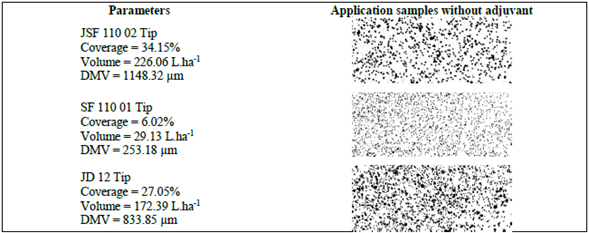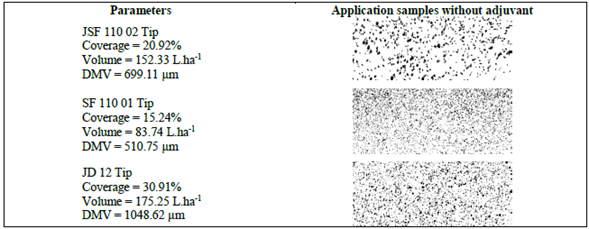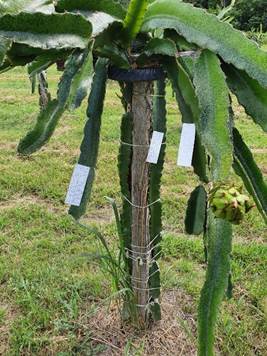1. Introduction
Pitaya is a tropical fruit that belongs to the family Cactaceae, has its origins in Mexico, Central America, and South America, and has a striking exotic flavor and color that has increasingly aroused the curiosity of several researchers. Among the various existing species, Hylocereus undatus is the most cultivated [1].
In Brazil, pitaya cultivation has made great progress in the last decade and continues to grow in production and commercialization [2]. Pitaya production is located mainly in the Southeast region of Brazil, with the largest producer being the state of São Paulo, with a production of 586 tons, registered by the 2017 Agricultural Census [3], recorded production of 586 tons. [4] cites the Southeast region as the largest national producer, followed by the South and North regions. Adding the three regions with the greatest expression of production. In addition, 98.56 % of what is produced throughout the territory coming from these 3 regions, with contributions of 54.42%, 33.62% and 10.52% respectively.
Pitaya has been cultivated in several municipalities in the State of Pará, including Tomé-Açu, Castanhal, Santo Antônio do Tauá, and Santa Izabel do Pará. The red-fleshed pitaya (Hylocereus costaricensis) is the main species, with production throughout the year. Fruits are usually sold in open-air markets or to other states due to the low production expression compared to other regions [5].
One of the main problems that burden and harm pitaya cultivation is the occurrence of pests and diseases despite being a crop of recent implementation, altering both the external and internal fruit quality, and detracting its commercial value. An alternative to circumvent the problem is the application of phytosanitary products, which prevent or reduce the damage caused by pests and diseases, consequently increasing crop productivity [6].
The application of phytosanitary products in pitaya fields is conducted as a preventive control. However, there are still no products registered in the Ministry of Agriculture, Livestock and Food Supply (MAPA) for pitaya cultivation, and the lack of a specific register for the crop leads to the use of unregistered phytosanitary products, resulting in an inefficient control, as they do not consider the plant characteristics, such as its structure, age, spacing, and cultural and environmental practices.
However, in addition to the product to be applied, the correct application method also needs to be known to ensure that the product reaches its destination efficiently, minimizing losses [7].
Application technology consists of using scientific knowledge to provide the deposition of the biologically active product correctly and effectively on the intended target, reaching pre-established parameters, such as the necessary quantity, also aiming at the economic value used in the activity, with minimal soil and water contamination of other areas.
Drift is one of the main reasons for the loss of phytosanitary products, occurring during or after application due to trajectory deviation, which is influenced by wind speed, application pressure, and droplet size [8].
In fact, the application technology basis must be well-balanced to allow success in the desired phytosanitary treatment. On the other hand, the unbalance of one of these factors, however minimal, can cause profound consequences for the entire application process. A reduction in the amount of pesticides used to spray certain crops has been observed over the years, which can provide several benefits, such as an increase in the treated area and a reduction in the fuel required for the sprayer to operate [9].
Although pitaya is considered a rustic crop, research on application technologies that are effective in controlling its pests is essential for producers to have strategic information, as few studies related to this subject have been conducted.
In this sense, this study aims to evaluate the spectrum of droplets of a spray solution with and without adjuvant using different spray tips, determine the 10% (DV01), 50% (DV05), and 90% volumetric mean diameter (DV09) of spraying on different tips, and establish which tip has the best droplet sizes for application.
2. Material and methods
The experimental test was conducted in a red pitaya (Hylocereus costaricensis) field at two years of age, with plants spaced at 3×4 m. An Adventure Bravo 400-L boom sprayer driven by an LS Tractor R60, 4x2 TDA traction, four-cylinder diesel engine, and a 62 hp power, was used. The sprayer operates with six spray tips, three tips for each side, with a spacing between nozzles of 50 cm. The pressure for all treatments was 55 psi and the travel speed was set at 5 km h−1.
The experiment was conducted in a randomized block design with four replications in a 3×2 factorial scheme, totaling 24 experimental plots. The treatments consisted of three spray tips (JD 12, SF 110 01, and JSF 110 02) and two spray solutions (with and without adjuvant addition). The spray solution with adjuvant was prepared with 0.5 mL L−1 of the adjuvant Potensil and dye for latex paint at the proportion of 0.5% of the spray solution. The spray solution without adjuvant was prepared with only black dye for latex paint at the proportion of 0.5% of the spray solution.
The temperature varied from 33 to 34 °C, the relative humidity was between 59 and 61%, and the wind speed ranged from 2 and 8 km h−1 (1.67 and 2.78 m s−1) during the applications. These conditions were obtained using an AKROM® KR825 portable digital thermo-hygro-anemometer.
Artificial targets were vertically distributed in four supports of the experimental area in each replication, with two supports for each side. Three targets were placed on the plant cladodes in each support (Fig. 1).
The artificial targets consisted of strips of white cardboard, measuring 10×4 cm, placed vertically on the pitaya cladodes. The targets were digitized after application with a black and white 600 dpi resolution in a scanner, generating an image file to be processed by the free software Conta Gotas. The following characteristics were evaluated: number of droplets (decimal), number of diameter (decimal), dispersion, volume (L ha−1), density (droplets cm−2), coverage (%), D10% (µm), D50% (µm), and D90% (µm).
Importantly, according to Chaim & Neto (2000), an adequate measurement regarding droplet size can only be performed using the software Conta-Gotas when the droplet density is low enough to allow no overlapping of spots, as the results of digitized images are unreliable. Therefore, the only parameter to be considered is the percentage of coverage, that is, the area covered by spots relative to the total area of the sample.
An analysis of variance at a 5% significance was performed and the mean values were compared using Tukey’s test at a 5% probability when its result was significant using the software Sisvar® version 5.3 [10].
3. Results and discussion
Table 1 shows the results of the analysis of variance and its significance for tips (T), spray solution (S), and their interaction.
Table 1 Summary of the analysis of variance in evaluating the effect of the factors: tips (P), spray (S) and their interaction in terms of the means of the number of drops, diameter number, dispersion, volume (L.ha-1) , density (Drops.cm-2), coverage (%), DV10% (µm), DV50% (µm) and DV90% (µm)
| Variation Factor | Block | Tips (P) | Spray (S) | P*S | Error | Total | CV% | |
|---|---|---|---|---|---|---|---|---|
| Mean squares | D.F. | 3 | 2 | 1 | 2 | 15 | 23 | - |
| Number of Drops | 95314,27ns | 19058,31ns | 5834,71ns | 49368,92ns | 67253,64 | - | 30,96 | |
| Number of Diameters | 1525,01ns | 27602,12** | 1688,27ns | 4264,95ns | 2538,89 | - | 24,64 | |
| Dispersal | 0,027ns | 0,042* | 0,012ns | 0,002ns | 0,011ns | - | 10,97 | |
| Volume | 6403,01ns | 42186,81** | 176,10ns | 8339,69ns | 2683,41 | - | 37,05 | |
| Density | 497,08ns | 64,20 ns | 27,99 ns | 312,46 ns | 306,99 | - | 30,71 | |
| Coverage | 291,71* | 833,10** | 0,017 ns | 274,99 ns | 79,99 | - | 39,96 | |
| D10% | 18965,07 ns | 157788,82** | 11,28 ns | 51349,96** | 8035,86 | - | 25,15 | |
| D50% | 263427,51* | 808768,17** | 356,74 ns | 314077,47* | 72735,22 | - | 36,01 | |
| D90% | 674299,07* | 1942647,01** | 7486,07 ns | 701433,32* | 167032,29 | - | 35,44 |
**significant at the 1% probability level; *significant at the 5% probability level; ns not significant.
Source: Prepared by the authors.
Table 1 shows that the characteristics number of diameter, volume, coverage, DV10%, DV50%, DV90%, and dispersion were significantly influenced by the factor tips, while the factor spray solution had no significant influence on the studied characteristics. The T*S interaction significantly influenced DV10%, DV50%, and DV90%.
The tip SF 110 01 showed a significant difference compared to the other tips, with the smallest number of diameter, volume, coverage, DV10, DV50, and DV90 (Table 2). This tip has fine droplets, being more influenced by drift and showing high evaporative losses [11]. In contrast, the tip provides coverage of the target and the number of droplets per cm2 that are usually high, with a high penetration capacity in the plant canopy, and reduced risk of leaf runoff.
Table 2 Average values for the number of diameter, dispersion, volume, coverage, DV10, DV50, and DV90.
| Spry | Tips | ||
|---|---|---|---|
| JSF 110 02 | SF 110 01 | JD 12 | |
| With Adjuvant | 335.31 Bab | 247.85 Ab | 484.06 Aa |
| No Adjuvant | 520.80 Aa | 141.37 Ab | 490.15 Aa |
Means followed by the same uppercase letter in the column and lowercase letter in the row do not differ statistically from each other by Tukey’s test at a 5% probability.
Source: Prepared by the authors.
The F-test showed a significant difference for this characteristic, but this difference is not identified by Tukey’s test, as the 5% probability value was probably very close to 5% and the Tukey’s test failed to identify it.
Table 3 shows the mean values in micrometers (µm) for DV10% (droplet diameter that constitutes 10% of the sprayed solution volume) for the T*S interaction. The spray solution showed a significant difference only when using the tip JSF 110 02. Moreover, this tip plus the spray solution with adjuvant had a smaller droplet diameter than the spray solution with adjuvant. Adjuvants that have surface tension-reducing ingredients in their composition can lead to a decrease in the droplet diameter and it varies according to the used tip [12].
Table 3 Mean values in micrometers (µm) for the diameter DV01 and the tip x spray interaction.
| Variables | Tips | ||
|---|---|---|---|
| JSF 110 02 | SF 110 01 | JD 12 | |
| Diameter number | 236.94ª | 136.6b | 239.8a |
| Dispersal | 1.01ª | 0.87a | 0.99a |
| Volume | 189.19ª | 56.43b | 173.82a |
| Coverage | 27.53ª | 10.62b | 28.98a |
| D10% | 428.06ª | 194.61b | 446.61a |
| D50% | 923.71ª | 381.97b | 941.24ba |
| D90% | 1,434.38ª | 584.22b | 1,441.06a |
Source: Prepared by the authors.
Means followed by equal letters in the same row do not differ significantly from each other by Tukey’s test at a 5% probability.
DV05, which represents the droplet diameter in which 50% of the sprayed volume consisted of larger droplets and 50% were smaller droplets (also called median volumetric diameter - MVD), showed that only the tip JSF 110 02 had a significant difference between the types of spray solutions (Table 4). [13] used adjuvant for agricultural application and observed that its behavior relative to the spray solution quality varied depending on the used tip.
Table 4 Mean values in micrometers (µm) for the diameter DV05 and the tip x spray interaction.
| Spray | Tips | ||
|---|---|---|---|
| JSF 110 02 | SF 110 01 | JD 12 | |
| With Adjuvant | 699.11 Bab | 510.76 Ab | 1,048.62 Aa |
| No Adjuvant | 1,148.32 Aa | 253.19 Ab | 833.85 Aa |
Me Means followed by equal letters in the same row do not differ significantly from each other by Tukey’s test at a 5% probability.
Source: Prepared by the authors.
The results for DV09 (Table 5), which represents the droplet diameter that constitutes 90% of the sprayed volume, showed that the tip JSF 110 02 had a significant difference between the types of spray solutions. An increase in droplet diameter is observed when compared to DV01, indicating an uneven application. [14] stated that DV09 must be as close as possible to DV01, thus presenting a homogeneity regarding the sizes of the produced droplets and higher spray solution quality.
Table 5 Mean values in micrometers (µm) for the diameter DV09 and the tip x spray interaction.
| Spray | Tips | ||
|---|---|---|---|
| JSF 110 02 | SF 110 01 | JD 12 | |
| With Adjuvant | 1111.18 Bab | 795.57 Ab | 1605.91 Aa |
| No Adjuvant | 1757.58 Aa | 372.88 Ab | 1276.23 Ba |
Means followed by the same uppercase letter in the column and lowercase letter in the row do not differ statistically from each other by Tukey’s test at a 5% probability.
Source: Prepared by the authors.
The tips JD 12 and JSF 110 02 provided a higher coverage rate, but they generated droplet diameters above 600 µm in both applications (Figs. 2 and 3), which are considered very thick droplets, being not recommended for pitaya crop, with a high susceptibility to runoff due to the plant architecture with cladodes in the vertical direction, facilitating even more runoff. The application of very thick droplets must be avoided in agricultural spraying, as they represent a risk to application safety. [15] reported that care must be taken with product losses if this type of tip is used, avoiding environmental contamination due to the running off of the droplets. [16] reported that the presence of contaminants in the soil for prolonged periods promotes its contamination, causing irreversible damage.

Source: Prepared by the authors.
Figure 2 Examples of droplet samples found in the application of spray solution without adjuvant, followed by the means for coverage, volume, and VMD.

Source: Prepared by the authors.
Figure 3 Examples of droplet samples found when spraying with adjuvant, followed by the means for coverage, volume and DMV obtained during the experiment.
The smallest droplet size was obtained by the tip SF 110 01 when applying the spray solution without adjuvant, which probably allowed a higher penetration and fixation on the cladodes, thus being indicated for pitaya spraying. According to [17], the transport of the active ingredient inside the plant canopy is a basic condition for the effective control of various pests and diseases. The tip SF 110 01 showed an increase in the droplet diameter, coverage, and deposition volume on the plant with adjuvant addition. Thus, the use of adjuvant is indicated, as it presents a better coverage rate and drift reduction. Therefore, adjuvant addition changed the pattern of sprayed droplets, corroborating the work conducted by [18]
The use of adjuvant led to an increase in both the coverage rate and the volumetric median diameter, with a higher surface contact with the target, which possibly favored conditions for the active product absorption. According to [18], adjuvants can reduce the surface tension of the droplet, providing higher wetting and spreading over the surface.
An average temperature of 33.5 °C, relative humidity of 60%, and a wind speed of 5 km h−1 were observed during the spray solution application. These values are close to ideal conditions for spraying. According to [8], the ideal temperature conditions for application must be less than 30 °C, the relative humidity must be above 60%, and the wind speed must be between 3 to 8 km h−1.
















